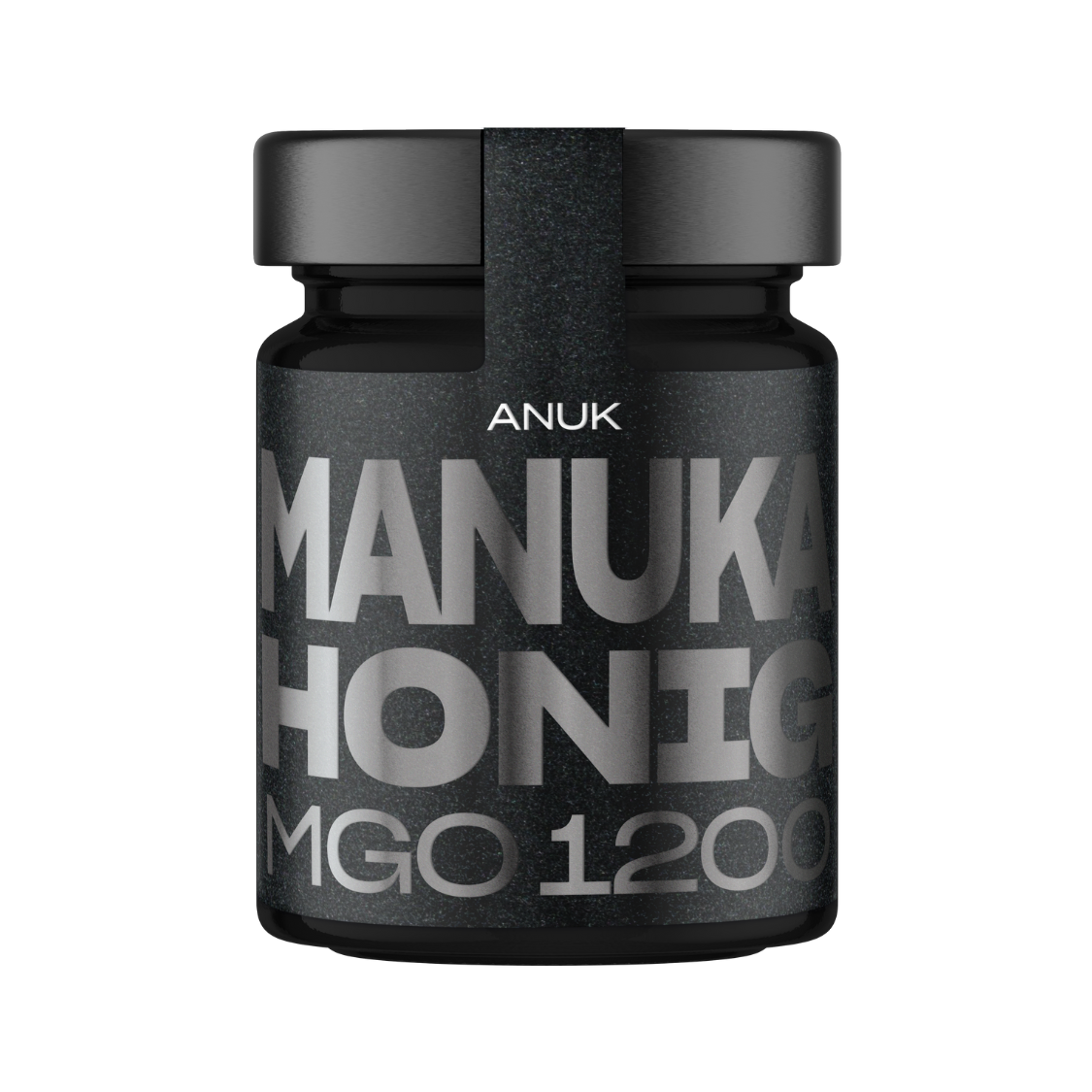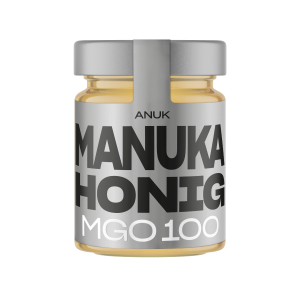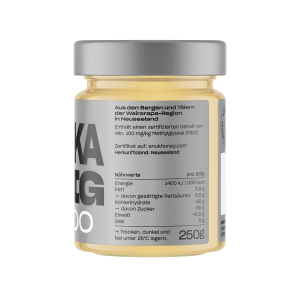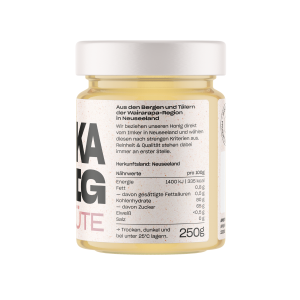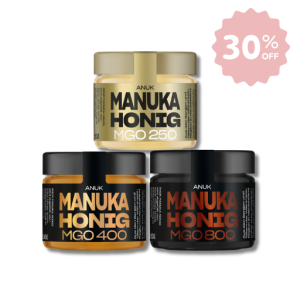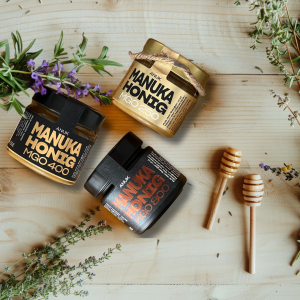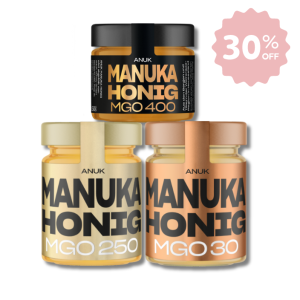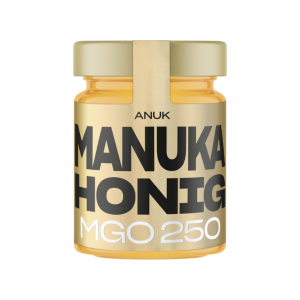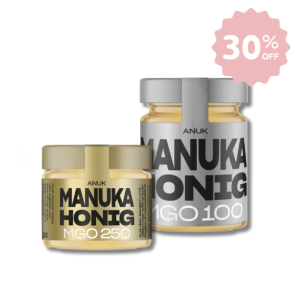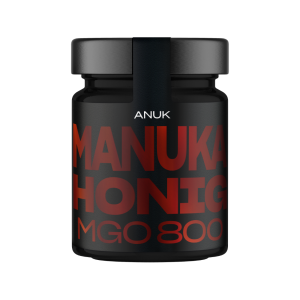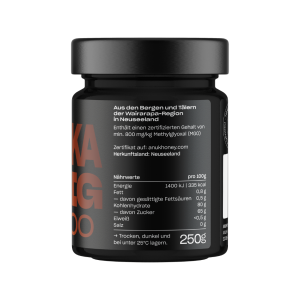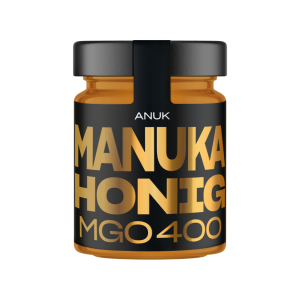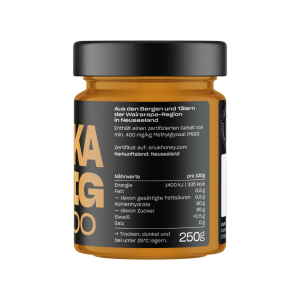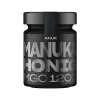MGO 1200
249,90 €
999,60 € / kg
incl. VAT zzgl. Versandkosten
Our Manuka Honey MGO 1200 is the prince among Manuka Honeys. An MGO content of at least 1200 mg/kg is extremely high and particularly rare: less than 1% of all Manuka honeys produced have such a concentration.
Quantity: 250g
* This product is only available with a German label.
Lieferzeit: 1-2 workdays
Lieferzeit: 1-2 Werktage
Versandkostenfrei ab einem Warenwert von 35 Euro!
Manuka Honey MGO 1200 – High Dose Rarity
As the prince among Manuka honeys, with an MGO content of at least 1200 mg/kg, it can count itself among the top 1% of all Manuka honeys produced. This rarity makes it a true wonder of nature and bundles the purity of the New Zealand wilderness in each glass. The powerful antiseptic properties, derived from the pristine environment of New Zealand, offer not only numerous health benefits, but also a taste that cannot be compared. The taste experience: refreshingly intense Manuka, an ethereal hint of tea tree, nutty sweetness with very dark undertones- juniper and incense. Still a long aftertaste of essential oil. A dark yet fresh, almost mystical taste.
Quality
The quality and therefore the origin of our Manuka honey has the highest priority for us. For this reason, we purchase honey only from selected beekeepers. Beekeepers we know personally and who have been working with us professionally for years.
In order to be able to guarantee and assure the quality of the honey, we refer to an extensive testing procedure. To guarantee that the MGO content is always at least 1200 milligrams per kilogram, all our products are tested and certified by two independent laboratories in New Zealand and Germany. Our honeys are always free of glyphosate and other residues. In addition, tests are carried out on various parameters that are important on the European market, including, for example, enzyme content. This means: We supply authentic, pure Manuka Honey according to New Zealand & European specifications and can prove it.

What does the MGO 1200 in Manuka Honey mean?
MGO stands for Methylglyoxal, a compound that occurs naturally in Manuka Honey and is responsible for its unique antimicrobial properties in high concentrations. As a rule, the higher the MGO content of a Manuka honey, the stronger its antibacterial activity. In Manuka honey MGO is the main indicator of quality, efficacy and authenticity of the product. For example, an MGO value of 1200 means that a certain amount of honey contains at least 1200 mg of methylglyoxal.
MGO stands for methylglyoxal, a compound that occurs naturally in Manuka honey and is responsible for its unique antimicrobial properties in high concentrations. As a rule, the higher the MGO content of a Manuka honey, the stronger its antibacterial activity. In Manuka honey, MGO is the main indicator of quality, efficacy and authenticity of the product. For example, an MGO value of 1200 means that a certain amount of honey contains at least 1200 mg of methylglyoxal. Not all Manuka honeys are the same. The MGO number on the package will help you judge the quality of the honey. Products with a higher MGO content tend to be more expensive because they contain a higher concentration of health-promoting compounds. When buying Manuka honey, always look for a certified MGO content to ensure you are getting an authentic and high quality product. This value should be clearly stated on the label and certified by a trusted source.
Not all Manuka honeys are the same. The MGO number on the package will help you judge the quality of the honey. Products with a higher MGO content tend to be more expensive because they contain a higher concentration of health-promoting compounds. When buying Manuka Honey, always look for a certified MGO content to ensure you are getting an authentic and high quality product. This value should be clearly stated on the label and certified by a trusted source.
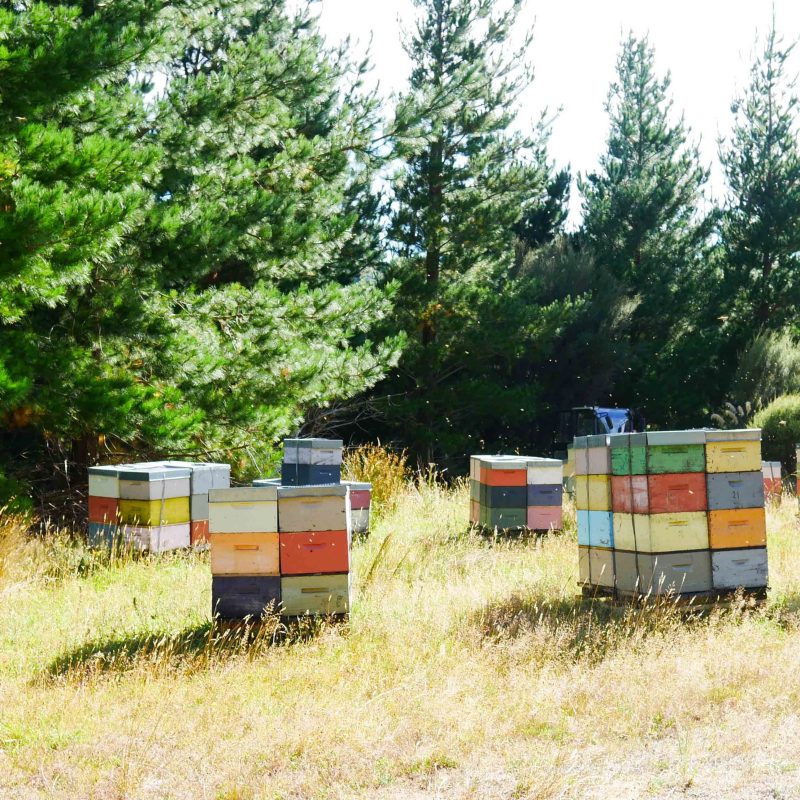

Where does Manuka honey come from?
Manuka honey comes from the pristine wild landscapes of New Zealand. This special honey is made from the nectar of the Manuka plant (Leptospermum scoparium), native to New Zealand’s unique and diverse flora.
The Manuka plant grows wild in New Zealand’s vast, unspoiled landscapes and is pollinated by honeybees. The bees collect the nectar and produce Manuka honey from it.
Because the Manuka plant is native only to New Zealand, this honey is unique and cannot be produced in other parts of the world.
The flavor intensity of Manuka honey can vary depending on the MGO content. Our Manuka Honey is produced in New Zealand under strict quality standards to guarantee its purity and high Methylglyoxal (MGO) content, which makes the honey so valuable and effective.

How to recognize the quality of Manuka honey?
The quality of Manuka honey can be determined by various indicators. Here are some important points to consider when choosing a quality Manuka honey:
MGO content: Methylglyoxal (MGO) is an important active ingredient in Manuka honey. A higher MGO value indicates a stronger antibacterial effect. This value is expressed in mg/kg.
Origin: Manuka honey comes from New Zealand and is produced by bees from the nectar of the Manuka plant. Make sure the honey is from New Zealand and comes from a reputable producer.
Certifications: Quality certificates such as the “New Zealand Made” mark or organic seals can provide further confidence in the quality of the product.
Processing: Raw and unfiltered honey usually contains more beneficial enzymes and nutrients than highly processed honey. Therefore, pay attention to processing instructions on the packaging.
Transparency: Trusted brands are usually transparent about their manufacturing processes, the origin of their products, and the results of their laboratory analyses.
How to recognize the quality of Manuka honey?
The quality of Manuka honey can be determined by various indicators. Here are some important points to consider when choosing a quality Manuka honey:
MGO content: Methylglyoxal (MGO) is the important active ingredient in Manuka Honey. A higher MGO value indicates a stronger antibacterial effect. This value is expressed in mg/kg.
Origin: Manuka honey comes from New Zealand and is made by bees from the nectar of the Manuka plant. Make sure the honey is from New Zealand and comes from a reputable producer.
How to recognize the quality of Manuka honey?
The quality of Manuka honey can be determined by various indicators. Here are some important points to consider when choosing a quality Manuka honey:
MGO content: Methylglyoxal (MGO) is an important active ingredient in Manuka honey. A higher MGO value indicates a stronger antibacterial effect. This value is expressed in mg/kg.
Origin: Manuka honey comes from New Zealand and is produced by bees from the nectar of the Manuka plant. Make sure the honey is from New Zealand and comes from a reputable producer.
Certifications: Quality certificates such as the “New Zealand Made” mark or organic seals can provide further confidence in the quality of the product.
Processing: Raw and unfiltered honey usually contains more beneficial enzymes and nutrients than highly processed honey. Therefore, pay attention to processing instructions on the packaging.
Transparency: Trusted brands are usually transparent about their manufacturing processes, the origin of their products, and the results of their laboratory analyses.

Certifications: Quality certificates such as the “New Zealand Made” mark or organic seals can provide further confidence in the quality of the product.
Processing: Honey filtered without heat usually contains more beneficial enzymes and nutrients than highly processed honey. Therefore, pay attention to processing instructions on the packaging.
Transparency: Trusted brands are usually transparent about their manufacturing processes, the origin of their products, and the results of their laboratory analyses.
Other frequently asked questions
Manuka honey is a unique natural product valued for its many health-promoting properties.
First, thanks to its strong antimicrobial activity, Manuka honey can support the immune system and act against various bacteria and viruses. It is helpful for colds and sore throats and can contribute to natural wound healing. This effect is especially found in honeys with high MGO values.
Secondly, Manuka honey is an excellent natural remedy for digestion. It can help with a variety of digestive problems, including heartburn, stomach ulcers and inflammatory bowel disease. Due to its anti-inflammatory properties, it can help calm the digestive system and promote gastrointestinal health.
Thirdly, Manuka honey can be used for skin care. Its antioxidant, antibacterial and anti-inflammatory properties can help reduce skin blemishes and promote skin health. It can be used as a moisturizer, in homemade face masks and scrubs.
In addition, Manuka honey is an excellent natural sugar substitute. Its rich and complex flavor makes it a wonderful addition to tea, yogurt, porridge and many other foods.
It is important to note that the quality and origin of Manuka honey matters. Look for certified products to ensure you get the full benefits of real Manuka honey.
The UMF Association (UMFHA) is dedicated to ensuring the integrity and quality of Manuka Honey on the global stage. This includes the obligation of its members to have their honey tested in neutral laboratories and to adhere to strict requirements.
The “Manuka Identification Project” was launched by the UMFHA in 2013 with the central goal of creating a specific profile for Manuka honey. This is to prevent counterfeiting and ensure quality. To do this, nectar and honey samples were collected from all regions of New Zealand and a chemical fingerprint of Manuka honey was determined using state-of-the-art chemical profiling methods.
This “fingerprint” is now used for the UMF classification. A honey may call itself UMF Manuka Honey if it contains DHA (dihydroxyacetone), leptosperin and methylglyoxal. Leptosperin is found exclusively in Manuka honey, which is a distinctive indication. Furthermore, the hydroxymethylfurfural content must not exceed 40mg/kg. The concentration of methylglyoxal is represented by the classification number, for example UMF13+ signals a methylglyoxal content of more than 550 mg/kg. This way, when you buy Manuka Honey from UMF member companies, you can be sure that you are buying genuine Manuka Honey with known antibacterial activity (UMF classification) and specific MGO content.
Manuka honey, this rare and precious gold from New Zealand, deserves its exceptionally high price for several reasons. Ursprünglich von den Bienen, die den Nektar der seltenen Manuka-Bäume sammeln, ist Manuka Honig nicht nur ein Produkt der Natur, sondern auch der Zeit und des Ortes.
The bees that produce this honey have only a short flowering period in the New Zealand summer to collect the nectar. They always rely on the natural conditions being just perfect to produce this rare product. This intensive, time-limited harvesting process underlines the high price of Manuka honey.
No less significant are the health benefits that Manuka honey offers. Thanks to its high concentration of methylglyoxal (MGO), it has remarkable antibacterial and anti-inflammatory properties that far exceed those of ordinary honey. This excellent therapeutic profile has made Manuka Honey a valued product in natural medicine and justifies its high price.
In addition, each drop of Manuka honey is subject to rigorous testing and certification to ensure its origin and quality. The tests confirm the MGO content and ensure that only genuine, high quality Manuka Honey enters the market. The cost of this quality assurance is also included in the final price of the honey.
Thus, the high price of Manuka honey is explained by the combination of limited production, complex harvesting process, remarkable health benefits and strict quality control. Despite the high price, Manuka honey remains a product whose exceptional properties and quality make it a highly valued natural product.
As a dog lover and connoisseur of Manuka Honey, one question always comes up: Can dogs also ingest Manuka honey? The answer is yes, however there are a few things to keep in mind.
First of all, Manuka honey, like all honeys, is a natural source of sugar. Too much sugar can lead to health problems such as obesity and diabetes in dogs. Therefore, honey should be given only in moderation and should not be the main source of food for your dog.
However, the therapeutic properties of Manuka honey can also benefit dogs. Its antibacterial and anti-inflammatory effects can help with minor wounds and skin irritations. A little Manuka honey on the affected area can help promote healing and prevent infection.
While Manuka Honey is safe and healthy for most dogs, there are some exceptions. Puppies and dogs with weakened immune systems should not be given honey because they are more susceptible to certain bacteria that may be found in honey.
Before giving Manuka Honey to your dog, always consult your veterinarian first. Although Manuka Honey offers many health benefits, it cannot replace the professional medical treatment your dog may need.

Other frequently asked questions
Manuka honey is a unique natural product that is valued for its many health-promoting properties.
First, thanks to its strong antimicrobial activity, Manuka honey can support the immune system in the long term. It is helpful for colds and sore throats and can contribute to natural wound healing. This effect is especially found in honeys with high MGO values.
Secondly, Manuka honey is an excellent natural wonder drug for digestion. It can assist with a variety of digestive problems, including heartburn, stomach ulcers, and inflammatory bowel disease. Due to its anti-inflammatory properties, it can help calm the digestive system and promote gastrointestinal health.
Thirdly, Manuka honey can be used for skin care. Its antioxidant, antibacterial and anti-inflammatory properties can help reduce skin blemishes and promote skin health. It can be used as a moisturizer, in homemade face masks and scrubs.
In addition, Manuka honey is an excellent natural sugar substitute. Its rich and complex flavor makes it a wonderful addition to tea, yogurt, porridge and many other foods.
It is important to note that the quality and origin of Manuka honey matters. Look for certified products to ensure you get the full benefits of real Manuka Honey.
The UMF Association (UMFHA) is dedicated to ensuring the integrity and quality of Manuka Honey on the global stage. This includes the obligation of its members to have their honey tested in neutral laboratories and to adhere to strict requirements.
The “Manuka Identification Project” was launched by the UMFHA in 2013 with the central goal of creating a specific profile for Manuka honey. This is to prevent counterfeiting and ensure quality. To do this, nectar and honey samples were collected from all regions of New Zealand and a chemical fingerprint of Manuka honey was determined using state-of-the-art chemical profiling methods.
This “fingerprint” is now used for the UMF classification. A honey may call itself UMF Manuka Honey if it contains DHA (dihydroxyacetone), leptosperin and methylglyoxal. Leptosperin is found exclusively in Manuka honey, which is a distinctive indication. Furthermore, the hydroxymethylfurfural content must not exceed 40mg/kg. The concentration of methylglyoxal is represented by the classification number, for example UMF13+ signals a methylglyoxal content of more than 550 mg/kg. This way, when you buy Manuka Honey from UMF member companies, you can be sure that you are buying genuine Manuka Honey with known antibacterial activity (UMF classification) and specific MGO content.
Manuka honey, this rare and precious gold from New Zealand, deserves its exceptionally high price for several reasons. Ursprünglich von den Bienen, die den Nektar der seltenen Manuka-Bäume sammeln, ist Manuka Honig nicht nur ein Produkt der Natur, sondern auch der Zeit und des Ortes.
The bees that produce this honey have only a short flowering period in the New Zealand summer to collect the nectar. They always rely on the natural conditions being just perfect to produce this rare product. This intensive, time-limited harvesting process underlines the high price of Manuka honey.
No less significant are the health benefits that Manuka honey offers. Thanks to its high concentration of methylglyoxal (MGO), it has remarkable antibacterial and anti-inflammatory properties that far exceed those of ordinary honey. This excellent therapeutic profile has made Manuka Honey a valued product in natural medicine and justifies its high price.
In addition, each drop of Manuka honey is subject to rigorous testing and certification to ensure its origin and quality. The tests confirm, among other things, the MGO content and ensure that only genuine, high quality Manuka Honey enters the market. The cost of this quality assurance is also included in the final price of the honey.
Thus, the high price of Manuka honey is explained by the combination of limited production, complex harvesting process, remarkable health benefits and strict quality control. Despite the high price, Manuka honey remains a product whose exceptional properties and quality make it a highly valued natural product.
As a dog lover and connoisseur of Manuka Honey, one question always comes up: Can dogs also ingest Manuka honey? The answer is yes, however there are a few things to keep in mind.
First of all, Manuka honey, like all honeys, is a natural source of sugar. Too much sugar can lead to health problems such as obesity and diabetes in dogs. Therefore, honey should be given only in moderation and should not be the main source of food for your dog.
However, the therapeutic properties of Manuka honey can also benefit dogs. Its antibacterial and anti-inflammatory effects can help with minor wounds and skin irritations. A little Manuka honey on the affected area can help promote healing and prevent infection.
While Manuka Honey is safe and healthy for most dogs, there are some exceptions. Puppies and dogs with weakened immune systems should not be given honey because they are more susceptible to certain bacteria that may be found in honey.
Before giving Manuka Honey to your dog, always consult your veterinarian first. Although Manuka Honey offers many health benefits, it cannot replace the professional medical treatment your dog may need.
| Weight | 0,405 g |
|---|
Versand, Lieferung & Bezahlung
Alle Preise inkl. aktueller Mehrwertsteuer. Versandkosten werden im Warenkorb angezeigt.
Versandbedingungen innerhalb Deutschlands
- Ab 35,00€: kostenlos
- bis 34,99€: 5,45€
Versandbedingungen innerhalb der EU
- Ab 100,00€: kostenlos
- Unter 100,00€: 12,00€
Versandbedingungen in die Schweiz
- Ab 150,00€: kostenlos
- Unter 150,00€: 25,00€
Akzeptierte Zahlungsmöglichkeiten
- PayPal
- Apple Pay
- Kreditkarte
Shipping, Delivery & Payment
All prices include the current VAT. Shipping costs are displayed in the cart.
Shipping conditions within Germany
- From 35,00€: free
- to 34,99€: 5,49€
Shipping conditions within the EU
- From 100,00€: free
- Below 100,00€: 12,00€
Shipping conditions to Switzerland
- From 150,00€: free
- Below 150,00€: 25,00€
Accepted payment methods
- PayPal
- Apple Pay
- Credit Card
Related products
All Products
incl. VAT
zzgl. Versandkosten
Special Offer
incl. VAT
zzgl. Versandkosten

